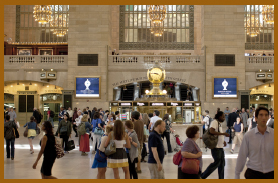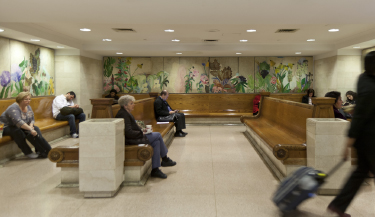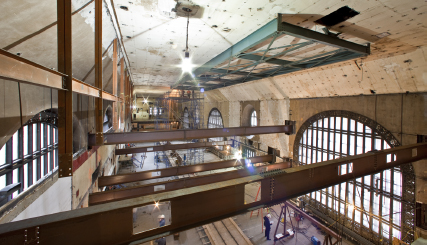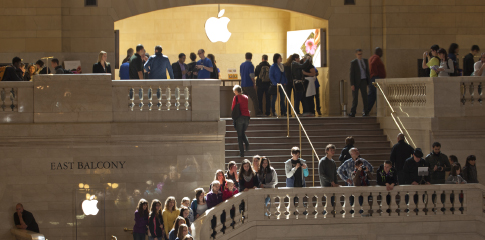

FOR A HALF CENTURY Grand Central’s peak traffic day had been reported as July 3, 1947, when 252,288 passengers arrived or departed for the Fourth of July weekend and the start of summer vacations. September 11, 2001, probably broke that record, but everybody was too busy to count.
Harry Kelly, the stationmaster, was on his way to work that morning from Tarrytown. After hearing the news, he ordered a Grand Central–bound through train to pick him up. “When it stopped at 125th Street,” he recalled, “I’ll never forget the look of people escaping the city and caked with dust and soot.” Fearful of further attacks, transit officials evacuated the terminal. Trains headed to Grand Central were halted north of 125th Street, reversed direction, and disgorged their passengers at outlying stations.
In front of the terminal, scores of travelers formed a semicircle around Millie Martinez, a New York City Transit employee, as she tried to direct straphangers to commuter trains because full service had not resumed on most subway lines. “If you are going to the Bronx, Queens or Brooklyn,” she said through a megaphone, “take the Metro-North train to Fordham Road. Then take the 12 bus to Pelham Bay. Then take the 14 bus to Parkchester. From Parkchester, you can take the Q-44 to Flushing, Queens. From Flushing, take the bus to where you’re going in Queens. And from Flushing you can also take the bus that you have to take to Brooklyn.”
Eventually, a single entrance to Grand Central, on Lexington Avenue, was reopened. Commuters were admitted one by one after being searched. Within a few hours, the terminal was teeming again. The first train left at 12:30 and, in a Dunkirk-like evacuation, one train after another departed for points north as soon as they were loaded. “People asked, ‘How far can I get?’ and bought tickets to the end of the line,” Kelly recalled.
Kelly, whose younger sister worked for a brokerage firm on the 22nd floor of One World Trade Center (she survived), remained at the terminal’s operation control center after a brief evacuation. He directed an assistant to the alternate command headquarters in Westchester in case it needed to be activated. “We had to wing it then,” he said. “Now we have a Code Black terror system.” Today, from the stationmaster’s office, surveillance cameras can scan and zoom in on virtually any cranny of the terminal, direct firefighters and personnel to the precise site of an emergency, and disable exhaust fans to stop the spread of smoke or other contaminants.
In New York City, the first decade of the 21st century—the 10th decade in the life of Grand Central Terminal—began with a tragedy of biblical proportions. Grand Central responded by serving as the city’s “ark.” Since then, the terminal has more than lived up to its name, aging with the grace and elegance of a dowager empress and the resourcefulness and resiliency of a nimble adolescent making the most of his capacity to grow.

THE EAGLE HAS LANDED—TWO OF THEM, IN FACT. THE RELICS OF THE OLD DEPOT NOW PERCH ABOVE THE TERMINAL’S ENTRANCES.
WHILE WILLIAM WILGUS’S ORIGINAL VISION for a glorious Terminal City flanking Park Avenue was never realized, the Grand Central Zone is ripe for redevelopment again. Plans call for more space for rent in the terminal itself and in new skyscrapers along the avenue.
In 1982, the City Planning Commission created a special Midtown zoning district to encourage development west of Sixth Avenue. The incentives worked. Spurred by the Renaissance of Times Square and the vast potential for the Hudson Yards west of Penn Station, Midtown West has boomed. Still on Mayor Michael R. Bloomberg’s agenda before he leaves office at the end of 2013 are zoning changes to revitalize Midtown East, where more than 80 percent of the office buildings are more than 50 years old. With tenants demanding floor space with higher ceilings and fewer columns, the existing zoning would allow only smaller buildings than those that now exist between Third and Fifth Avenues and from East 39th Street to East 59th.
So far, only two buildings, the former Philip Morris headquarters on 42nd Street and the 47-story 383 Madison between 46th and 47th Streets (originally the Bear Stearns Building, later owned by JPMorgan Chase), which opened in 2001, have been built with the air rights from Grand Central.

A NEW WAITING ROOM DECORATED WITH MURALS COMMISSIONED BY ARTS FOR TRANSIT AND ORIGINAL BENCHES.
The planning commission was expected to approve rules that would ease the transfer of more than a million square feet of remaining air rights from Grand Central and provide other incentives to develop as much as 4.4 million more square feet in the corridor, including the MTA’s own headquarters building at 347 Madison, and 237 Park, which also owns Depew Place, the tiny street astride the terminal between Lexington and Park. Depew Place also borders the Grand Central Post Office, which is the oldest survivor—opened in 1909 and older even than Grand Central itself—of the original Terminal City built atop the railroad’s marshaling yards. In 1992, a 38-story skyscraper, 450 Lexington Avenue, was completed above the post office, whose first floor of red granite and upper stories of limestone are separated by a limestone band decorated with—what else?—acorns.
MORE DEVELOPMENT AND MORE PASSENGERS also mean more pedestrians. They finally caught a break after decades of terrifying attempts to cross the Fourth Avenue train tracks during the 19th century and almost as perilously dodging motor vehicles in the 20th on the half-mile between 46th and 56th Streets mysteriously devoid of “Walk/Don’t Walk” signs.
The reason the signs were missing was not aesthetic. Rather, they posed an engineering challenge. Park Avenue is really the “roof” of the Grand Central train yards; the side streets are bridges that span the avenue. The deck is only 18 to 24 inches thick—not thick enough to support the foundation ordinarily required for traffic signal poles without piercing the rail-tunnel roof.
For decades, recalcitrant railroad executives accustomed to getting their way rebuffed city officials, who didn’t want the blame for disrupting train service. “In dealing with the railroads in those days, it was like dealing with an alien from another planet,” said Sam Schwartz, who was the city’s traffic commissioner in the 1980s. “The bureaucracies spoke completely different languages. The railroads thought they received some kind of right to do whatever they wanted to do when Adam left Eden, that it was somehow divinely given to them.” Finally, in 2007, city transportation commissioner Janette Sadik-Khan and Eliot G. Sandler, then the executive director of the MTA (and Sadik-Khan’s predecessor), agreed to install 12 “Walk/Don’t Walk” signs and 8 traffic signals at 11 intersections after figuring out a way to anchor them in the roadway without causing leaks in the rail-yard roof.
In the last decade, pedestrians have also benefited from the opening of entrances to the terminal from as far north as 48th Street through a 1,000-foot-long Northwest Passage and a 1,200-foot-long Northeast Passage that run parallel to the Upper Level tracks.
WHEN METRO-NORTH acquired Conrail’s commuter operations in New York and Connecticut in 1983, regular commuters accounted for 65 percent of the railroad’s passengers on the three lines east of the Hudson River. By 2005, their share had fallen to 49.4 percent. (Reverse commuters, while still a distinct minority, grew to 6 percent of Metro-North riders from 2 percent during the same period.) Since 1984, the number of New York City–bound commuters has climbed 17 percent, while the number of other riders rose 126 percent. Regular commuters to Manhattan still fill about two-thirds of the seats sold on weekdays, but the railroad has aggressively courted other categories of off-peak riders (a strategy that William Wilgus had suggested as early as 1918: “An increase from 10 percent of the railroad’s 24-hour capacity to 20 percent would cut the fixed charges per passenger in half and reduce the total cost by some 25 percent”). Since 1985, Metro-North has increased the number of weekday trains from 471 to more than 600. In mid-2012, MTA Chairman Joseph Lhota announced that the railroad would add 230 more trains, mostly in off-peak hours and on weekends, in what he described as the largest service expansion since Metro-North’s inception.
On-time performance has reached a record high (for 2011, 97.4 percent on the Hudson, 97.1 percent on the Harlem, and 93.7 percent on the New Haven for the morning rush; and 98.5 percent, 97.8 percent, and 95.1 percent, respectively, in the afternoon). So has annual passenger traffic. Since 1983, when Metro-North was created, ridership has doubled. It topped 82 million in 2011, when, for the first time, the number of Metro-North commuters surpassed their Long Island Rail Road counterparts (even before the East Side Access project, now scheduled for completion by 2020, delivers another 40,000 a day to Grand Central) and was projected to grow between 2 and 4 percent in 2012.
METRO-NORTH ESTIMATES that 10,000 people come to Grand Central every weekday just to eat (among the 150,000 or so daily walk-ins, plus 60,000 tourists, 130,000 subway riders and 400,000 Metro-North passengers—for a total of nearly 275 million annually). Revenue from more than 70 tenants occupying 134,000 square feet of retail space has soared from $7 million in 1994, before the terminal was renovated, to $27 million gross in 2011 (compared to operating expenses for retail operations of less than $10 million and for the entire terminal, including electricity, sanitation, other employees, and materials of about $50 million). Revenue per square foot, said Paul Kastner, a vice president of Jones Lang LaSalle, which manages commercial rentals for the MTA, surpasses that of many successful shopping malls. Renting out Vanderbilt Hall and the taxi stand generated nearly $3 million in 2010. With Michael Jordan’s steak house and the Oyster Bar already calling Grand Central home, leases were signed for another Danny Meyer Shake Shack and an Eli’s bread and vegetable venue, and the MTA said it was soliciting bids for two more restaurants, a 12,300-square-foot space that includes the west side of Vanderbilt Hall, and a 4,700-square-foot location above Grand Central Market. (In addition to generating revenue, the influx of diners also produced long lines for women’s restrooms, a consequence Metro-North resolved by reserving the restrooms in the waiting room near the stationmaster’s office for women only.)

EMPLOYEE LOCKERS AND LOUNGES BEING BUILT ABOVE THE OLD WAITING ROOM IN 2010. THE SPACE HAS HOUSED A GALLERY, STUDIOS, AND TENNIS COURTS.
Some older tenants complained that Grand Central was being transformed into a trendy, but faceless, suburban mall. In 2009, Alfred Catalanotto’s Central Market Grill was replaced by a takeout version of the Napa Valley steakhouse Tri Tip Grill. (Catalanotto, whose family has operated food shops in the terminal for more than three decades, opened a hot-dog stand called Frankies Dogs on the Go on the Lower Level.)
Scott Stein, whose family opened Grand Central Jewelers in the terminal in 1923, said a few years ago that his 500-square-foot Grand Central Optical in the Lexington Passage was more successful than a second 1,100-square-foot store he opened on Madison Avenue when the terminal was being renovated. “My return is 70 percent higher in Grand Central,” he said, where people are now more likely to linger and spend money than when the terminal was a decrepit hulk (or when it first opened and the Central boasted that “every facility is progressively arranged so that no step need be retraced, no time lost”).
Jeanne Giordano, who was hired by Metro-North in 1988 to help remake the station, couldn’t believe the contrast between then and today—when most of the 300 applicants for 74 booths at the December holiday fair in 2011 had to be rejected and long-time tenants have to compete with hungry newcomers when their leases expire. Some became victims of their own success. “Twelve years ago, I didn’t want to come there, there was nothing there,” said Sushil Malhotra, who was courted to open Café Spice and Feng Shui and who will have to compete in the public renewal process when his leases expire in 2015. “But now, because I’m successful there, anybody can outbid me.” One measure of the competition is the lengths to which Apple computer went in its bid to open its largest store in the nation on the terminal’s East Balcony in 2011, where the baggage check used to be. Apple paid $5 million just to buy out the prior tenant’s lease. Its bid (Apple’s rent starts at $1.1 million annually, but the lease does not include a share of sales) was formally submitted in linen-lined boxes, like a “wedding gift,” to Metropolitan Transportation Authority officials.

APPLE INC. TASTEFULLY JOINED THE TERMINAL’S OTHER TENANTS IN 2011, ON THE EAST BALCONY ATOP THE NEW STAIRCASE.
EXTENDING COMMUTER SERVICE farther north on the Hudson line has met with mixed reviews, from residents who fear overdevelopment versus developers and would-be commuters. In 2001, the Harlem line was extended from Dover Plains to Wassaic. Further expansion beyond Dutchess County into Columbia County would require an amendment to the Metropolitan Transportation Authority’s charter and would also subject residents of Columbia County to MTA taxes. In 2009, Metro-North opened a new station, Yankees–East 153rd Street, which provides access to the new Yankee Stadium from the Harlem, Hudson, and New Haven lines. The Harlem and New Haven now have access to the Hudson line station through Mott Haven in the Bronx, the first time that regular service has operated on that section of the junction. On the New Haven, a new station was being built in West Haven, the overhead catenary system was being upgraded, and sections of track were being straightened to accommodate the 150 mph maximum of Amtrak’s Acela.
The LIRR’s East Side Access project was projected in 1978 to cost $332 million and take less than seven years to complete. By 2004, it was supposed to cost $4.4 billion and be completed in 2012. The cost estimate has skyrocketed to nearly twice that amount and the debut of the new service is now scheduled for 2019 at the earliest. (If that seems like a long wait, consider that a proposed link was first reported by the Times in 1885.) A 350,000-square-foot concourse will eliminate 15 tracks in the Madison Avenue train yard, which has a storage capacity of 165 rail cars, and the terminal’s lower loop for turnarounds—leaving 14 platform tracks on the Lower Level, plus one reserved for freight, and 29 on the Upper Level, plus one for trash removal. To complete the project, Amtrak has to tunnel under the Harold Interlocking in Sunnyside, Queens (named for Harold Avenue, which became 39th Avenue), where 14 tracks converge and the daily complement of 600 commuter trains and 48 Amtrak trains make it the busiest rail intersection in the country. Many Metro-North officials privately consider the access project a boondoggle, forced on them by Senator Alfonse M. D’Amato as what amounted to a going-away present to his Long Island constituent base.
Even when the East Side Access is complete, don’t hold your breath for a direct connection between Grand Central and Penn Station—even though the Long Island Rail Road’s new bilevel eight-track tunnel into Grand Central from Queens via the lower level of the 63rd Street subway tunnel actually extends as far south as the East 30s to provide a storage area for idle trains (so burrowing less than a half mile more west might not seem so daunting). Also, the long-delayed transformation of the Farley post office building on Eighth Avenue into a spiffy Moynihan Station, named for the senator who championed public transportation, might help bring to the forefront a connection that has been on the back burner for decades. To access the West Side station and provide intermediate service in the Bronx and Manhattan, southbound New Haven trains could switch to the Hell Gate line in New Rochelle and Hudson trains could switch at Spuyten Duyvil and proceed under Riverside Park on Amtrak’s Empire Connection.
THE METROPOLITAN TRANSPORTATION AUTHORITY barred smoking on all commuter trains back in 1988, but bar cars—“lurching lounges,” one writer called them—have survived several attempts to phase them out. Grand Central itself got greener during its 10th decade. The terminal claims to have the largest newspaper-recycling program under one roof in the entire country. About four tons of newsprint are collected for recycling daily and taken by rail to the Bronx. Every two or three days, 13 tons of discarded newspapers are removed, for a total of 352 tons in 2010.
Incandescent bulbs were replaced everywhere and even the stars in the zodiac burned more brightly. Decades of 10-watt incandescent bulbs and then fiber-optic tubes that dimmed since they were installed in 1997 were replaced in 2010 by light-emitting diodes, not only producing a more accurate intensity of the stars but also saving manpower and electricity. A chemical heat-absorption system that uses steam to cool the terminal with 3,000 tons of chilled salt water daily is being converted from steam to electric.
While the sky ceiling attracts most of the attention, about a quarter of the 45,000 square feet of pink marble floor was being replaced as the terminal entered its second century. The quarry where the marble originated closed in the 1980s but was reopened to accommodate the project. A two-year, $21 million exterior restoration was begun in 2003 to remove the soot from auto exhaust that had clung to the terminal’s 21,000 limestone blocks since they were last bathed three decades before. The famous clock, tongues of solar flares radiating from its center, was regilded with 23.75-karat Italian gold, and the four-ton statue of Commodore Vanderbilt got new steel supports and was gently blasted clean with walnut shells.
THAT GRAND CENTRAL SURVIVED because it was landmarked has been greeted ambivalently whenever custodians of the terminal have sought to renovate. Deciding whether to belatedly install the east staircase that was originally proposed created a hubbub in the 1990s. Preservation watchdogs approved the conversion from incandescent lights to fluorescent (although Metro-North had to search for round bulbs because the common spiral versions didn’t conform to the terminal’s landmark status), but a proposal to add moving images to the digital advertising signs at the entrance to train platforms was rejected. It was okay to use exterior doorframes with gray-green Benjamin Moore No. 214040 and to install the eagle on the Park Avenue viaduct, but nine oak columns topped by light fixtures at a restaurant on the southwest balcony were deemed three too many. Watchdogs objected when the Oyster Bar installed a 12-foot-long sign, a re-creation of one that had been destroyed in a fire in 1997. The old sign could have remained indefinitely, but the restaurant required permission from the landmarks commission to re-create it.
IN PART FOR PIONEERING THE CONCEPT OF AIR RIGHTS, in 2012 the American Society of Civil Engineers designated Grand Central as a National Historic Civil Engineering Landmark, an honor it shares with the Erie Canal and the Hoover Dam. Andrew W. Herrmann, president of the society, said that in addition to its architectural bona fides, the terminal “also represents a triumph in civil engineering, a fact that goes unnoticed because much of the engineering work that went into the design and construction of the terminal is largely hidden from view.” Moreover, the society said, “The system still works, as the terminal accommodates 750,000 visitors daily and more than 750 incoming and departing trains.” In 2011, Metro-North also became the first American railroad to win the international Brunel Award for design excellence from the Watford Group and the Center for Industrial Design in Transportation. “Metro-North carries the most passengers every year on the American continent,” the award citation said, “and has undergone both extraordinary changes of company culture as well as the shift to incorporation of design as a strategic business tool.” Metro-North president Howard Permut said the award recognized “Metro-North’s 30-year-long sea change from an unreliable and decrepit railroad into the premier passenger railroad in North America.”